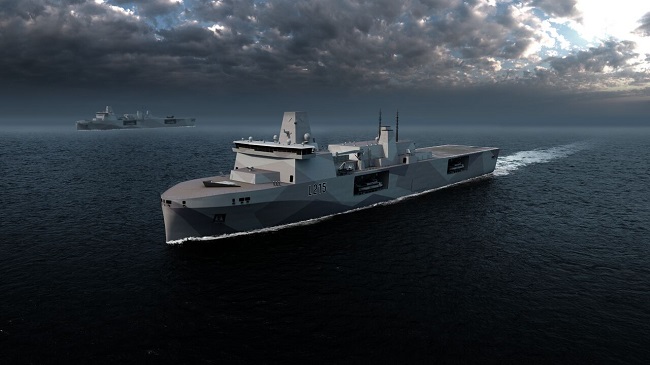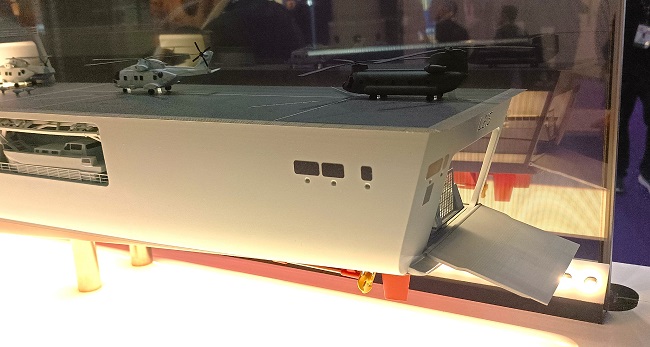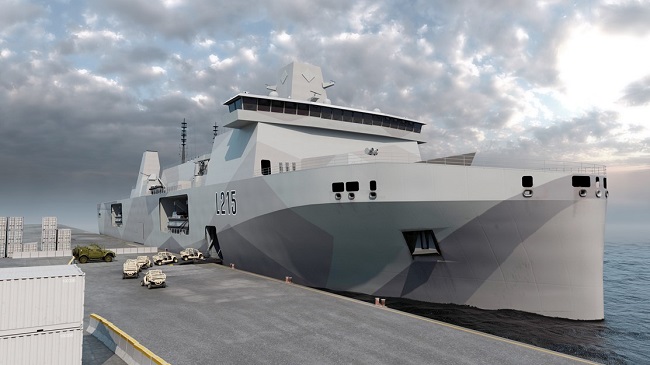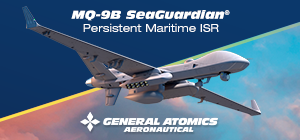
The Royal Navy and Royal Marines have by now outlined their main requirements and wishes for the Multi Role Strike Ships, “up to” 6 of which are meant to be built to replace, in the early 2030s, the BAY-class LSDs, the lone RFA ARGUS and the (already decommissioned) 2 ALBION-class LPDs.
The MRSS will be (relatively) conventional LPDs in nature: their main focus is going to be surface manoeuvre ship-to-shore, although they are also required to have a substantial hangar for helicopters.
The introduction of “Strike” in the name, which replaced the earlier “Support” openly signals the intent to have the new vessels play a more offensive role.
BMT’s response, presented at DSEI 2025 in London, is a modular LPD which, in its “full optional” guise is larger than the ALBIONs at 213m in length, 35m in beam, 7m draught and displacement of around 29,500 tonnes, although the design is scalable and can be reduced, obviously with an impact on the hangar (from 4 down to 2 MERLIN HC4 plus drones) and vehicle/cargo deck.
ELLIDA STRIKE would have a well dock roughly half the size of that of an ALBION, for 2 LCU Mk10 or equivalent. The designers favoured a full width dock with the 2 LCUs parked abreast rather than in tandem, because this ensures that a fault with one LCU cannot also “trap” the other, and that the well dock can be flooded without docking down the ship, but rather maintaining a more even trim.
The LCU Mk 10 is expected to eventually be replaced by a new Commando Utility Craft which will have to offer far greater speeds in order to enable ship to shore manoeuvres over the horizon from far greater distances. BMT offers its CAIMEN 90 landing craft, already selected by Japan, which sails at well over twice the LCU Mk 10’s speed when at full load (22 knots with a MBT on deck).
The ELLIDA STRIKE also has 4 side bays for the new Commando Insertion Crafts, the LCVP Mk5 replacement, that the Royal Marines are expected to select and order in the new year.
The vehicle/cargo “flexible” deck offers up to 8,000 lane meters of space (obviously it depends primarily on the width of the lane and thus the size of vehicles embarked), of which up to 6700 on the main deck and 1600 for lighter vehicles/payloads on a mezzanine deck accessible by ramp.
The forward end of the Flexible deck can be partitioned to be adapted, thanks to the embarkation of containerized capability modules (the Royal Navy’s NAVYPODS) for various missions, including Role 2+, potentially Role 3, medical facilities.
Up to 8 containers/NAVYPODs can also be carried on the weather deck amidship, opening up options for embarking “offensive” NAVYPODS such as drone/loitering munition launchers.
The flight deck can handle 2 CH-47 CHINOOKs simultaneously: this was possible also on the ALBIONs, but the ELLIDA STRIKE adds a hangar that can accommodate up to 4 MERLIN-sized helicopters and/or a mix of UAVs.

The ship comes with permanent Role 1+ medical facilities with surgical threatre and a 43-beds ward, with some space available for expansion also in the superstructure. The medical complex has direct access to the flight deck as well as a dedicate connection to the forward end of the Flex Deck, so it can expand as needed in either direction. Some of the designers were involved in the realization of the Role 3 hospital facility on RFA ARGUS and carried that experience over into the new design.
The landing force’s normal size would be 250, rising to 350 in “surge” conditions. Up to 150 elements can be embarked for the air component between helicopters and drones. A lift connects the hangar and the Flex Deck. Vehicles access the ship via the stern or via a side ramp.
The “Strike” capabilities of the ELLIDA come from a proposed 16-cell Mk-41 silos as well as the embarkation of suitably containerized weapon payloads. Self defence is entrusted to 2 BAE-Bofors Mk4 40 mm guns and 2 laser weapons (DRAGONFIRE, in the current model); 2 ANCILIA trainable decoy launchers deploy chaff, flare and active countermeasures, while 2 dedicate SEA SENTOR launchers deploy anti-torpedo decoys.
The model also shows a number of fixed SEA GNAT type decoy launcher tubes. An integrated mast would bring an adequate radar fit to enable the increased combat capability of the ship.
BMT is considering various alternatives for propulsion. A fully electrical solution with the use of Azipod propulsors is a possibility. BMT is collaborating with GE VERNOVA for the possible adoption of an Integrated Full Electric architecture with Active Stator rotating machines and their new HALO distribution system, an advanced development that the Royal Navy funded in 2024.
This innovative arrangement removes the need for converters and propulsion shipboards, saving space and weight and enhancing efficiency.
The more likely propulsion arrangement, however, is a low risk hybrid Diesel/Diesel-Electric solution with controllable pitch propellers on conventional shafts. This solution would deliver a great level of commonality with the propulsion arrangement of the new Fleet Solid Support ships, themselves also a BMT-led design.









.png)
